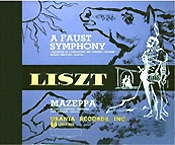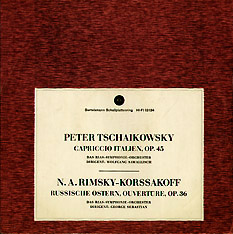

Georges
Sebastian around 1950.
Picture taken from the cover of Urania URLP 7061 released in the fall
of 1952.

Georges
Sebastian's Urania recording of Liszt's Faust Symphonie.

Symphony
Fantastique on the German Diamant label licensed by Remington Records



|
In
an old encyclopedia it was stated that Sebastian's actual name was
György Sebestyén but he westernized it to George Sebastian.
As he lived in Paris from 1947 on, his Christian name is written Georges
with an 's', the French way, although he often is listed as George
as well. And his Family name is sometimes written as Sebastien.
Georges
Sebastian was born in Budapest on Aug. 17, 1903 and died (according
to Larousse Encyclopedia) on April 12th, 1989 in Hauteville (Yvelines),
located southwest of Paris.
The
liner notes of Remington R-199-176 mention:
'(...)
he studied with Leo Weiner and Zoltán Kodály.
He conducted with Bruno Walter in Munich and then came to the
US as assistant conductor at the Metropolitan Opera House. His
career took him back to Europe where he was engaged as conductor
of the Opera Houses of Hamburg, Leipzig, Berlin and Barcelona.
He returned to America to perform with the Buenos Aires and
Rio de Janeiro Operas, the San Francisco Opera and the CBS nationwide
network. Since 1947 he has been first conductor of the Paris
Grand Opera and a regular conductor of the Concerts Colonne
Paris.'
|
To
most music lovers Sebastian is known as the conductor of the live-performance
of the second act of La Tosca (Puccini) with Maria Callas and
Tito Gobbi with the Orchestra and Chorus of the 'Théatre National
de l'Opéra de Paris' on December 19, 1958 (Maria Callas: Débuts
à Paris, 1958), his collaboration with Kirsten Flagstad in
recordings of 1948 and 1951, and the Paris debut of Leontyne Price
in Aida.
Georges
Sebastian - at the pinnacle of his career - recorded many works for
the Urania label:
Albeniz
(Ibéria), Dukas (Symphony in C, La Péri; C-7097), Fauré (Pelléas et
Mélisande; C-7097), Franck (Les Djinns; 7099), Schubert: (Symphonies
No. 3 and 6 with l'orchestre des Concerts Colonne; 7137), Granados
(Spanish Dances; 7144), d'Indy (Istar Variations; C-7115), Lalo (Rhapsodie
Norvégienne, Symphony No. 2; C-7156), Liszt (Dante Symphony; C-7103),
Liszt (Faust Symphony; C-606), Prokofiev (Symphony No. 4; A-7139),
The Prodigal Son (Prokofiev; A-7139), Respighi (Brazilian Impressions;
A-7144), Saint-Saëns (Carnival of Animals; C-7099), Schubert (Symphonies
Nos. 3 and 6; A-7137).
For Urania he also conducted the complete recording of 'Thais' (Massenet;
B-227) and of 'Werther' (Massenet; with Juyol, Leger, Richard, Rouquetty,
Bourdin, 233 (3Lp) and for English Decca 'Lakme' (Delibes; London
5134).
Remington Recording Director  Laszlo Halasz knew of course his
fellow countryman and asked Sebastian to record for Remington Records
with the RIAS Symphony Orchestra and with the Orchestra of the Teatro
La Fenice.
Laszlo Halasz knew of course his
fellow countryman and asked Sebastian to record for Remington Records
with the RIAS Symphony Orchestra and with the Orchestra of the Teatro
La Fenice.
|
|
|
The
Remington Musirama cover of Symphony Fantastique (R-199-176)
|
With
the  RIAS Symphony Orchestra
he recorded for Remington:
RIAS Symphony Orchestra
he recorded for Remington:
R-199-174
- Wagnerian Favorites: Tannhäuser (Prelude to Act III, Arrival
of the Guests at the Wartburg), Lohengrin (Prelude to Act III), Meistersinger
(Prelude, Dance of the Apprentices and March).
R-199-176
- Symphonie Fantastique (Berlioz). According to the French web site
Patachon this same recording was available on Musidisc RC 830 and
the conductor's name was Thomas Greene conducting the London Festival
Orchestra and as year of recording 1966 is mentioned.
R-199-177
- Wagner Overtures: Lohengrin (Prelude to Act 1), Meistersinger (Prelude
to Act 1), Tannhäuser (Overture to Act 1; Bacchanale)
|
|
|
Wagnerian
Favorites on Remington R-199-174 - Cover by Kaebitz
|
Wagnerian
Overtures on Remington R-199-177- Cover by Kaebitz
|
R-199-208
- Suite from Coppélia (Delibes) - coupled with the Suite from Sylvia
conducted by Anatole Fistoulari. In 1967 these performances were reissued
on Everest 6116 (mono) and 3116 (stereo). The availability of this
recording in stereo proves that Don Gabor and Laszlo Halasz made these
recordings in stereo, though not on 35 mm film; the 35 mm could only
have been used by Everest for the initial transfer of the original
tapes; but it is unlikely that they worked that way. The Everest release
not only shows that the sound technique of these recordings was excellent,
given the year they were recorded in, but also the performances are
noteworthy.
And
with the Teatro La Fenice:
R-199-175/2
- 'Cavalleria Rusticana' (Mascagni) - a 2 record set.
This complete recording with the 'Teatro la Fenice' conducted by George
Sebastian, had singers Teresa Apolei, Pina Geri, Antonio Spruzzola
Zola, Piero Campolonghi and Letizia Del Col. This set replaced the
earlier recording with conductor Erasmo Ghiglia conducting the Fiorentino
Chorus and Orchestra, and singers Vassilka Petrova, Edward Ruhl, Ivan
Petroff and Benucci.

More
recordings were made with Georges Sebastian conducting but they were
not released by Remington, yet appeared on Tefi Schallbänder
in Germany:
* Ponchielli: Danse of the Hours
* Rimsky-Korsakov: Russian Easter (coupled with Capricio Italien conducted
by Wolfgang Sawallisch released on Bertelsmann HIFI 13 134)
* Saint-Saëns: Danse macabre
* Saint-Saëns: Bacchanale from Samson and Delilah
|
|
|
Georges
Sebastian (1903-1989) around 1955.
Photograph taken from an advertisement
of Remington Records in Dutch record publication Discopaedie
from 1955.
|
In
March 1955 Dutch music critic Jan de Kruijff reviewed Sebastian's
performance of Symphony Fantastique for the monthly record magazine
'Luister...' and compared the release to the already existing recordings
of Willem van Otterloo (Philips), Eduard van Beinum (Decca), Pierre
Monteux (RCA), and Igor Markevitch (Deutsche Grammophon). Though the
performance of the latter conductor was "the winner" of
the lot, George Sebastian's Remington disc received praise. De Kruijff
wrote:
The
Remington-recording according to the Musirama-system is a
revelation of richness of sound. The performers, the RIAS
Symphony Orchestra conducted by George Sebastian, give a glowing
performance. At several instances the effects seem a bit would
be. The groups of instruments have been treated too much in
an individual manner in contrast to the (English) Decca-recording,
which lacks this. While listening, the impression is that
we are not seated in the hall but it looks as if we are walking
through the orchestra and at one moment are placed amidst
the first violins and at another instance we land in the vicinity
of the percussion-section, which does not result in the correct
impression of the work. In this way the work gets a transparent
character. The display of space is good; regrettably the brass-section
sounds rather dry. The fourth movement in particular sounds
very suggestive. - Jan de Kruijff - March, 1955.
|
There
are a few recordings of Sebastian on other labels:
* Chopin: Piano Concerto No. 1 with Reine Gianoli and the Baden-Baden
Radio Symphony Orchestra - CLUB FRANCAIS DU DISQUE 368
* Strauss: Der Rosenkavalier, Act 3, the San Francisco performance
recorded in 1945 with Lotte Lehmann, Alvary, Rise Stevens, Glaz, -
GOLDEN AGE OF OPERA EJS 462
* Excerpts from Bizet's Carmen with Rise Stevens \Connor\Jobin - OA
5X 5 x COLUMBIA 78D. 152
* Massenet: Thais with Boue, Monmart, Riquier, Leroy - PRESIDENT UPR
10005
* Excerpts from Siegfried with Kristen Flagstad (coupled with excerpts
from Die Walküre, conducted by Karl Böhm EMI FALP 30311
* Strauss: Tod und Verklärung, Rosenkavalier Suite with the Orchestra
of the Südwestfunk - CLUB FRANCAIS DU DISQUE 328
* Thomas: Mignon with Janine Micheau, Noel Pierotte, Genevieve Moizan,
a.o. 3 x LONDON ALA 15
* Two fine performances were recorded in 1963 by VEB Deutsche Schallplatten
in the than German Democratic Republic in cooperation with EMI: Schönberg's
'Verklärte Nacht' and Mahler's 'Adagio' from Symphony No. 10.
EMI produced a very fine release of these recordings with the Gewandhaus
Orchester Leipzig. These recordings can be found on the Eterna label
as well.

Rudolf A. Bruil.
Page first published January 16, 2003.
|

